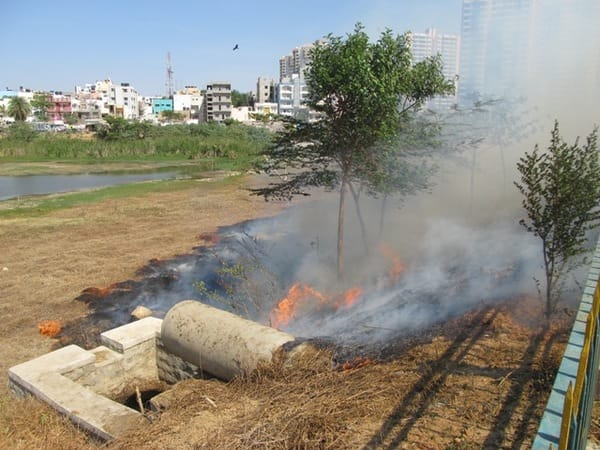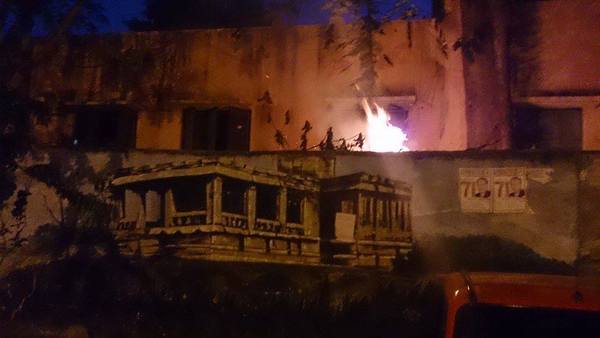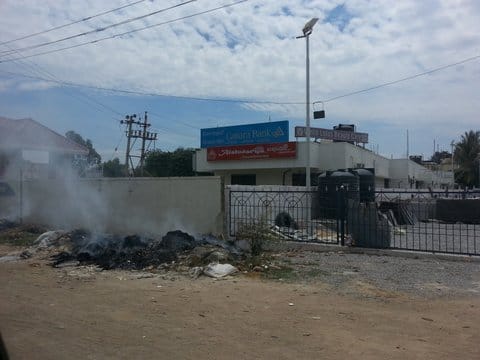The receding rains and the advent of summer is the time when the lush green landscape in Bangalore turns to crisp brown. Rain-fed lakes are just about holding out, trying hard not to become parched playgrounds.
This summer-time drying kills off aquatic weeds and gives fresh life to the lakes before the next rains. Lake care-takers get an opportunity to attend to the lake beds, repair silt traps, clear out water inlets, and do other things that need to be done before the onset of the next monsoon. The grass, weeds and many of the plants on lake revetments, dry out and lie dormant. Gardeners and cleaners are usually kept busy clearing out unwanted weeds, and watering the plants to keep them alive through the scorching heat.
This period of summer dryness is also the time when fire fighters are kept fairly busy. And dry lakesides, untended vacant plots, open drains, leaf piles and roadside garbage dumps, are the waiting victims, given that all it takes is a spark to get the fire going.
Fire on lake premises
Over the last two weeks, a few fire incidents have been reported at some lakes of Bangalore, through the Save Bangalore Lakes email group.
Rajesh Rao, of the Mahadevapura Area Parisara Samrakshane mattu Abhivruddhi Samiti (MAPSAS), overseeing the maintenance of Lower Ambalipura Lake lake, spotted the fire from his house a couple of Sunday nights ago, near Lower Ambalipura lake. Seeing that the fire was manageable, he got the security guards from his building to help him douse the flames with several buckets of water. It is suspected that the fire was caused by someone throwing an unextinguished cigarette butt.
A few days later, there was a fire at Kaikondrahalli Lake (Bellandur area). A garbage pile on the outside of the lake boundary fence had been set ablaze and the fire had quickly spread into the lake area. Priya Ramasubban (from MAPSAS) says that it took several hours to put out the flames, and not before a tree and a brush pile were burnt. Later they found the charred remains of six piglets in the brush.
At about the same time, a fire at Kasavanahalli Lake (Bellandur area) scorched more than 150 metres of the grass bund. One of the residents from the vicinity said that a group of young boys had been drinking and smoking and they intentionally started burning the dry grass. He tried to stop them but had to back off as they were aggressive. He was thoughtful enough to douse one of the ends of the bund with water, so the fire died down when it reached there.
At Puttenahalli Lake (JP Nagar area), the Holi Sunday afternoon was spent battling a fire. The gardeners had the day off and the home guard on duty was not around. Usha Rajagopalan (from PNLIT) who lives next to the lake reported that she spotted smoke and rushed to the lake with her friends. By the time they reached, the fire had spread on one side of the revetment and into the dry parts of the lake bed. OP Ramaswamy (from PNLIT) said that the flames were looking so dangerous that they decided to call the fire brigade. By the time the fire was put out, a number of trees and shrubs, tenderly-nurtured over the last three years, had been burnt or singed. The water birds had moved away, but the fate of the smaller birds that frequented the bushes in the burnt area was not known.
If not controlled, the fire could have moved towards the encroaching hutments on the lake bund. It is most likely that this fire, as with the one at Lower Ambalipura, was caused by a cigarette or beedi carelessly being tossed. On talking to the people in the neighbourhood, some admitted that they had seen the fumes but did not get alarmed as “it is common to see burning piles and smoke everywhere”.

Fire at Puttenahalli Lake (Pic: Usha Rajagopalan)
Fire at public places
Burning garbage is a common habit across the city. Summer time is also a time when many trees start shedding their leaves, and roads are piled up with leaves. An easy method to dispose them off is to burn them!
Vani Murthy, a resident of Malleshwaram, spotted fire inside a school complex near 18th cross. When checked, a security guard was disposing of the garden waste by burning it – inside the school compound, at night. In a post on Malleshwaram Rising Facebook page, she suggested that the school should be instructed strictly not to do this in future, and there should be a robust complaint redressal forum for such issues to be addressed.

Fire at Government Boys’ School compound in Malleshwaram (Pic: Vani Murthy)
Archana Prasad Kashyap has reported several other instances of burning in the Bellandur/Sarjapur area, through the Forward150 email group.

Roadside buring in Bellandur area (Pic: Archana Prasad Kashyap)
Why these fires?
Two factors really form the crux of the matter:
1. Lack of civic sense and caring for public spaces (including parks, footpaths, roads, drains, etc.)
2. Acceptance of burning of different things (including garbage, plastic, garden waste, etc.) as a method of disposal.
Both these can be addressed only through education at all levels, starting with young children as a part of the school curriculum. While doing this, putting out the facts and awakening people to the fears of ill-health and dangers to the next generation, would probably be the best way.
The pollution facts
In a study by Tel-Aviv University (2012), India topped the list of countries for air pollution increase. And Bangalore earned the dubious distinction of witnessing the second-highest increase (34%) in air pollution levels among the 189 cities studied, after Portland (USA).
A report by the Centre for Science and Environment (CSE) on the state of air pollution and mobility (March 2013) lists Bangalore among the highly polluted cities in India. With increasing levels of particulate matter, benzene, nitrogen dioxide and others, the CSE report indicated an imminent “multi-pollutant crisis” in Bangalore.
The Global Burden of Disease report (2013) lists outdoor air pollution as the fifth largest killer, and the seventh biggest illness burden in India.
Yale’s Environmental Performance Index (2014) ranks India’s air quality at Rank 174 out of 178 countries. More people die of asthma in India, than any other place on earth. A study conducted by Lakeside Medical Centre, Bangalore (2009) reported that 25% of children in Bangalore suffered from asthma, and the numbers are said to be increasing, due to air pollution.
GV Dasarathi, a 54-year-old citizen who cycles around Bangalore has recently put together a presentation Stop killing your child. It focuses on the effect of suspended particulate matter – asthma, cancer, heart attack and loads of other problems. While the emphasis of the presentation is on pollution caused by automobiles, it would not be wrong to extend it to other forms of air pollution, including those caused by burning garbage, plastic, garden waste and other things.
What can be done to prevent/ minimise incidents of burning and the resulting damage?
To address the dumping
- Put up “No dumping” / “No garbage” / “Dumping is punishable” / “Health hazards of garbage” and other such signs prominently in public places
- Instruct BBMP sweepers, contractors, rag pickers, and public not to dump leaves, garden waste, debris and other garbage in open drains
- Enforce segregation of garbage at source (wet and dry)
- Provide disposal spots for moving population (like people walking, vendors, etc.)
- Close open drains so that they are not used for dumping, and get them regularly cleaned
- Pick up garbage promptly to eliminate the need for people to dump
- Enforce composting of wet waste/ garden waste in commercial buildings/ large buildings/ schools/ other bulk generators/ parks and other public spaces
- Provide composting sites in every neighbourhood, on the same lines as the waste collection centres
- Impose heavy fines/ penalties on those dumping/ not segregating/ not composting
To address the burning
- Put up “No burning” / “Burning is illegal” / “Health hazards of burning” and other such signs prominently in public places
- Instruct the BBMP sweepers, contractors, rag pickers, and public not to burn garbage, leaves, etc.
- Do not allow accumulation of piles that can be burnt – promptly dispose / compost waste
- Impose heavy fines/ penalties on those caught burning
To address the smoking
- Put up “No Smoking” / “No throwing cigarette butts” / “Punishable” signs prominently in public places
- Request the security guards/ citizens in the area to stop smokers and to ask them to extinguish the cigarettes/beedis
Request citizens in the area to promptly report any dumping/ burning/ fires (keep the local RWA/ NGO and fire department numbers at hand)
Report miscreants /violators to the police (keep the local police contact numbers at hand)
Many of these measures will need the backing of BBMP/ local police / fire department. Experiences at some lakes indicate that the support received is generally good with quick response rates. Vigilance is the key and it is up to the citizens, local groups and “rising” communities in Bangalore to fight to keep their right to clean air.
Issues related to garbage, including burning can be reported to BBMP at 22660000 or to the BBMP Environment Department officers of your area, whose numbers can be found here or to the SWM monitorning officials whose numbers can be found here. You can also call the BBMP helpline on 22221188 to find the number of the relevant person who you can complain to or Mr Prasad, Chief Engineer (East) on 22975518 or 9480684531.
Related Articles
Bangalore rising, inspired by The Ugly Indian
Rising communities reclaiming our public spaces
Cancer institutes under the lens: radioactive waste
A health crisis in the making
What is surprising is that in the age of inter space travel we cannot install a tested and used process to eliminate waste and dispose garbage
We have called BBMP on 22660000 and made a complaint. They have called back to check if the issue has been resolved – it hasn’t – we have been pouring mugfulls of water in the mean time. They have apparently informed the inspector, we are yet to see the +ve outcome!
Rajesh Rao (from Mahdevapura Area Parisara Samrakshane mattu Abhivruddhi Samiti (MAPSAS) overseeing the maintenance of Lower Ambalipura Lake ) spotted the fire from his house a couple of Sunday nights ago, near Lower Ambalipura lake, still accumulation of leaves’dumping i going on there in his campus under his eyes and some day burning also could happen, if BBMP authorities still don’t care as I have brought this to BBMP’s notice through it earlier also and mailing to Mr. Kaushik and Mrs. Vani to seek help as it had been dumped since more than a year and visible from lakeside. Its in the backyard of Trinity Woods & Acres.